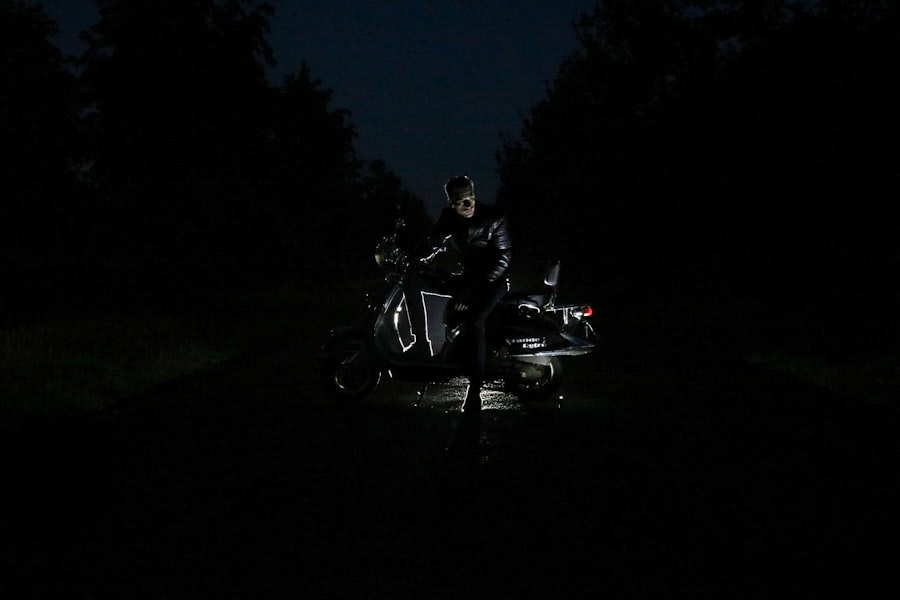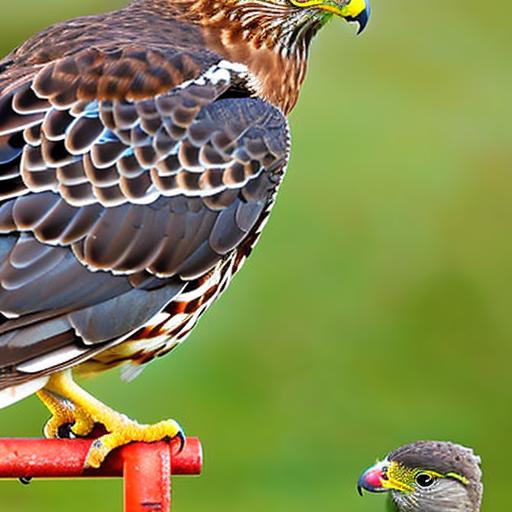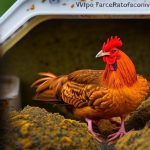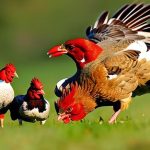Hawks are a common predator that can pose a threat to backyard chicken flocks. These majestic birds of prey have keen eyesight and powerful talons, making them formidable hunters. Protecting your flock from hawks is essential to ensure the safety and well-being of your chickens. In this article, we will explore the different types of hawks, their behaviors, and provide tips on how to create a safe and secure chicken coop.
Key Takeaways
- Hawks target chickens as a source of food and may attack during the day or night.
- Different types of hawks have different behaviors, with some being more likely to attack chickens than others.
- A safe and secure chicken coop with sturdy walls and a roof can help protect chickens from hawks.
- Protective netting and fencing can also be installed to keep hawks out of the chicken coop area.
- Decoys and deterrents such as scarecrows, reflective tape, and noise makers can help scare off hawks.
Understanding the Threat: Why Hawks Target Chickens
Hawks target chickens for several reasons. Firstly, chickens are easy prey for hawks due to their size and vulnerability. Chickens are ground-dwelling birds that lack the ability to fly long distances or defend themselves effectively against aerial predators. Additionally, chickens’ bright plumage and movement can attract the attention of hawks, making them an enticing target.
Another factor that makes chickens vulnerable to hawks is their predictable behavior. Chickens have a routine of going outside during the day and returning to the coop at night. Hawks can learn these patterns and wait for the opportune moment to strike when the chickens are outside and unprotected.
Identifying Different Types of Hawks and Their Behaviors
There are several different types of hawks that may target chickens. The most common ones include the Cooper’s hawk, the red-tailed hawk, and the sharp-shinned hawk.
Cooper’s hawks are medium-sized hawks known for their agility and speed. They have adapted well to urban environments and can often be found in suburban areas where backyard chicken flocks are prevalent. Cooper’s hawks have a hunting pattern known as “wait-and-ambush,” where they perch in trees or on fences, waiting for an opportunity to swoop down on their prey.
Red-tailed hawks are larger birds with broad wings and a distinctive red tail. They are skilled hunters that can take down prey as large as rabbits and squirrels. Red-tailed hawks are known for their soaring flight and can often be seen circling high in the sky, scanning the ground for potential prey.
Sharp-shinned hawks are small hawks with short wings and long tails. They are agile hunters that specialize in capturing small birds. Sharp-shinned hawks have a hunting pattern known as “fast pursuit,” where they chase their prey through trees and shrubs, using their maneuverability to their advantage.
Creating a Safe and Secure Chicken Coop
| Aspect | Metric |
|---|---|
| Size | Minimum of 4 square feet per chicken |
| Roosting | Provide at least 8 inches of roosting space per chicken |
| Nesting | Provide one nesting box for every 3-4 chickens |
| Ventilation | Ensure proper ventilation to prevent respiratory issues |
| Lighting | Provide 14-16 hours of light per day for optimal egg production |
| Security | Use sturdy materials and secure locks to prevent predators from entering |
| Cleanliness | Clean coop and nesting boxes regularly to prevent disease and pests |
Creating a safe and secure chicken coop is crucial for protecting your flock from hawks. The coop should be constructed with sturdy materials that can withstand the force of a hawk’s attack. Reinforce the walls, roof, and doors to ensure they are predator-proof.
Proper ventilation is also essential to prevent overheating and the buildup of ammonia from chicken droppings. Install wire mesh or hardware cloth over windows and vents to keep hawks out while still allowing for adequate airflow.
Installing Protective Netting and Fencing
Installing protective netting and fencing around your chicken coop can be an effective way to keep hawks out. Use heavy-duty netting or wire mesh with small openings to prevent hawks from entering the coop. Make sure the netting is securely attached to the coop to prevent any gaps or openings.
Fencing can also be used to create a barrier around the coop and run area. Use sturdy materials such as welded wire or chain-link fencing that is at least six feet tall to deter hawks from attempting to enter. Bury the bottom of the fence at least one foot deep to prevent predators from digging under it.
Using Decoys and Deterrents to Scare Off Hawks

Using decoys and deterrents can help scare off hawks and discourage them from targeting your chickens. Place scarecrows or life-sized hawk decoys near the coop to create the illusion of a larger predator in the area. Hawks are territorial and may be less likely to approach if they believe another predator is present.
Reflective tape or shiny objects can also be effective deterrents. Hang strips of reflective tape or CDs near the coop to create flashes of light that can startle hawks and make them think twice before approaching.
Providing Adequate Shelter and Hiding Places for Chickens
Providing adequate shelter and hiding places for chickens is essential for their safety. Hawks are less likely to attack if they cannot easily see or access the chickens. Planting shrubs or trees around the coop can provide natural cover and hiding places for chickens.
Inside the coop, provide roosting bars and nesting boxes where chickens can perch and lay eggs. These elevated areas can offer additional protection from hawks, as they are less likely to venture into confined spaces.
Implementing a Buddy System for Chickens
Implementing a buddy system for chickens can help protect them from hawks. Pair up chickens so that they have a companion to watch out for each other. Chickens have a natural instinct to flock together, and having a buddy can provide an extra set of eyes to spot potential predators.
Using Sound and Light to Keep Hawks at Bay
Using sound and light can be an effective way to keep hawks at bay. Playing a radio near the coop can create noise and disturbance that may deter hawks from approaching. Additionally, installing motion-activated lights around the coop can startle hawks and make them think twice before attempting an attack.
Educating Yourself on Local Laws and Regulations
It is important to educate yourself on local laws and regulations regarding the protection of chickens from hawks. Some areas may have specific guidelines or restrictions on how you can protect your flock. Familiarize yourself with these laws to ensure you are in compliance while still taking necessary measures to protect your chickens.
Seeking Professional Help and Advice if Necessary
If you are facing persistent hawk predation despite your best efforts, it may be necessary to seek professional help and advice. Local wildlife experts or veterinarians can provide guidance on additional measures you can take to protect your flock. They may also be able to offer insights into the specific behaviors and patterns of hawks in your area.
Protecting your flock from hawks is essential to ensure their safety and well-being. By understanding the threat, identifying different types of hawks, and implementing various protective measures, you can create a safe and secure environment for your chickens. Remember to educate yourself on local laws and regulations and seek professional help if necessary. With these precautions in place, you can enjoy the benefits of raising chickens while keeping them safe from hawks.
If you’re a chicken owner, you know how important it is to protect your flock from predators. Hawks can be a major threat to chickens, but there are ways to keep them away. In a related article on Poultry Wizard, you can learn effective strategies on how to keep hawks away from your chickens. From installing scare devices to creating safe hiding spots, this article provides valuable tips and insights for safeguarding your feathered friends. Check out the article here and ensure the safety of your chickens against these aerial predators.
FAQs
What are hawks?
Hawks are birds of prey that belong to the family Accipitridae. They are known for their sharp talons and beaks, which they use to catch and kill their prey.
Why do hawks attack chickens?
Hawks attack chickens because they are a source of food. Chickens are easy prey for hawks because they are slow-moving and cannot fly very high.
What are some signs that hawks are attacking my chickens?
Some signs that hawks are attacking your chickens include missing or injured chickens, feathers scattered around the coop, and hawk sightings in the area.
How can I keep hawks away from my chickens?
You can keep hawks away from your chickens by using deterrents such as scarecrows, reflective tape, and predator decoys. You can also provide your chickens with cover and shelter to make it harder for hawks to attack them.
Are there any natural predators of hawks?
Yes, hawks have natural predators such as eagles, owls, and other larger birds of prey. However, these predators are not commonly found in areas where hawks attack chickens.
Is it legal to kill hawks that are attacking my chickens?
No, it is illegal to kill hawks or any other birds of prey. Hawks are protected under the Migratory Bird Treaty Act, which makes it illegal to harm or kill them without a permit.
Meet Walter, the feathered-friend fanatic of Florida! Nestled in the sunshine state, Walter struts through life with his feathered companions, clucking his way to happiness. With a coop that’s fancier than a five-star hotel, he’s the Don Juan of the chicken world. When he’s not teaching his hens to do the cha-cha, you’ll find him in a heated debate with his prized rooster, Sir Clucks-a-Lot. Walter’s poultry passion is no yolk; he’s the sunny-side-up guy you never knew you needed in your flock of friends!







